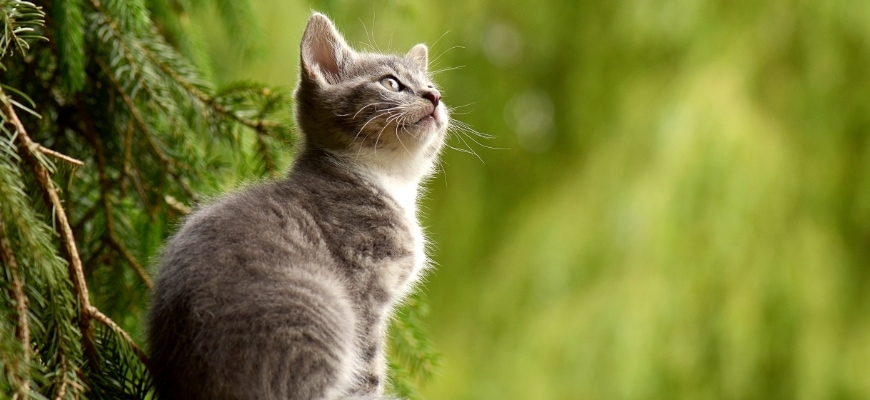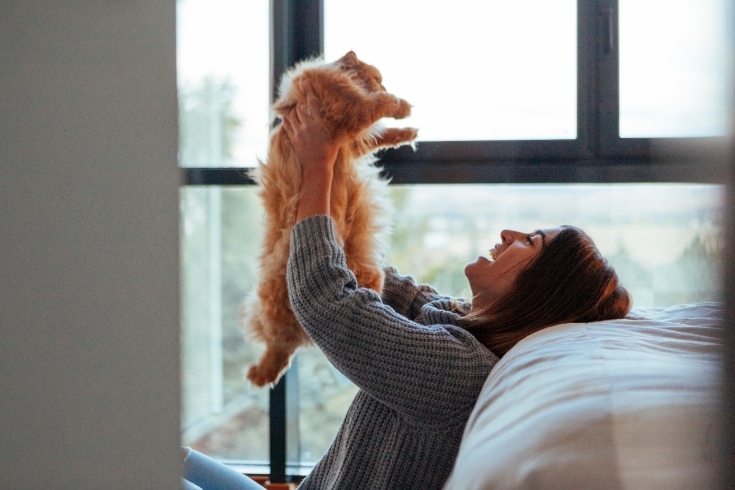Cat Years Explained
Cats grow and age quite differently from humans. Understanding how cat years compare to human years is essential for providing proper care at each stage of your feline friend’s life. The concept of “cat years” helps us comprehend and appreciate a cat’s unique aging process.
When calculating cat years, the first two years are crucial. In their first year, cats mature rapidly, reaching the equivalent of 15 human years. The second year adds an additional 9 human years, bringing a 2-year-old cat to around 24 human years old. From there, each subsequent feline year equals roughly 4 human years.

This accelerated aging during the initial years accounts for the rapid development and maturation cats experience. After their first two years, their aging process slows down, allowing them to enjoy several more years of adulthood before reaching seniority.
It’s important to note that the cat years to human years conversion is just an estimate. Factors like breed, lifestyle, diet, and veterinary care can influence a cat’s rate of aging. Some felines may age more quickly or slowly than the general guideline. However, this conversion provides a helpful reference point for understanding your cat’s life stage and tailoring their care accordingly.
Feline Growth Stages
A cat’s life can be divided into four distinct growth stages: kitten, young adult, mature adult, and senior. Each stage brings unique physical and behavioral changes that require tailored care and attention.
Kitten Stage (0-1 Years)
The kitten stage is a whirlwind of growth and development. During this time, kittens go through rapid physical changes, learning essential survival skills, and establishing their personalities. Proper nutrition, socialization, and veterinary care are crucial during this foundational stage.
Young Adult Stage (1-6 Years)
As kittens transition into young adults, their growth rate slows down, and their bodies and minds reach full maturity. This is typically a cat’s most active and playful stage, where they exhibit peak agility, curiosity, and energy levels. Providing interactive toys, scratching posts, and environmental enrichment can help channel their exuberant nature.
Mature Adult Stage (7-10 Years)
During the mature adult stage, cats enter their prime years. While they may be less rambunctious than in their youth, mature adult cats still enjoy playing and exploring. Regular exercise, a balanced diet, and preventive veterinary care can help maintain their health and vitality.
“Cats are incredible creatures. They are often seen as solitary and independent, but they form deep bonds with their human companions and thrive on consistent care and affection throughout their lives.” – Dr. Jane Wilkinson, Veterinarian
Senior Stage (11+ Years)
- As cats enter their senior years, they may experience physical and cognitive changes that require special attention.
- Arthritis, vision or hearing loss, and age-related illnesses may become more common.
- Providing a comfortable living environment, adapting litter boxes and scratching posts for easier access, and maintaining regular veterinary check-ups can help ensure their golden years are peaceful and comfortable.
Understanding your cat’s growth stage helps you anticipate their needs and provide the best possible care. By recognizing the unique demands of each life phase, you can foster a strong bond with your feline companion and ensure they thrive at every age.
Cat Age Conversion Chart
Decoding the mystery of cat years is like unlocking a secret language – once you understand it, you can communicate and care for your feline friend on a deeper level. To help you navigate this intriguing world, we’ve created a handy cat age conversion chart.
This chart serves as your trusty guide, translating your cat’s age into human-relatable years. But remember, the conversion is just an estimate. Every cat is unique, and their aging process can be influenced by various factors. The chart provides a general reference, but don’t treat it as the definitive truth.
So, take a moment to study the chart below, and let your curiosity run wild. Can you spot any patterns or surprises? Perhaps you’ll discover that your furry companion is much younger (or older!) at heart than you thought.
| Cat Age | Human Age |
|---|---|
| 1 year | 15 years |
| 2 years | 24 years |
| 3 years | 28 years |
| 4 years | 32 years |
| 5 years | 36 years |
| 6 years | 40 years |
| 7 years | 44 years |
| 8 years | 48 years |
| 9 years | 52 years |
| 10 years | 56 years |
| 11 years | 60 years |
| 12 years | 64 years |
| 13 years | 68 years |
| 14 years | 72 years |
| 15 years | 76 years |
| 16 years | 80 years |
| 17 years | 84 years |
| 18 years | 88 years |
| 19 years | 92 years |
| 20 years | 96 years |
As you explore this chart, you might be surprised to learn that a 10-year-old cat is the equivalent of a 56-year-old human! Or perhaps you’ll discover that your 5-year-old feline friend is actually closer to middle age than you thought.
The key to truly understanding your cat’s age lies not just in the numbers but in observing their behavior, energy levels, and overall well-being. Use this chart as a starting point, but let your own observations and your veterinarian’s guidance steer you in providing the best possible care for your furry companion at every stage of their life.
Factors Influencing Lifespan
While the cat age chart provides a helpful guideline, several factors can influence a cat’s lifespan and rate of aging. Understanding these elements can help you make informed decisions to promote your feline friend’s longevity and well-being.
Genetics
Just like humans, a cat’s genetic makeup plays a significant role in determining their lifespan. Certain breeds may be predisposed to specific health conditions that can impact their overall longevity. Mixed-breed cats often benefit from a phenomenon called “hybrid vigor,” which can contribute to a longer lifespan.
Diet and Nutrition
Providing your cat with a balanced, high-quality diet is crucial for maintaining their overall health and preventing obesity-related issues. A nutritious diet can reduce the risk of developing conditions like diabetes, heart disease, and certain cancers, ultimately promoting a longer life.
Living Environment
The environment in which a cat lives can significantly impact their lifespan. Indoor cats are generally safer from outdoor hazards like vehicular accidents, fights with other animals, and exposure to infectious diseases. However, indoor living must be enriched with mental stimulation and opportunities for exercise to prevent obesity and behavioral issues.
Veterinary Care
Regular veterinary check-ups, vaccinations, and preventive care play a vital role in detecting and managing health issues early on. Cats that receive consistent, high-quality veterinary care tend to live longer and enjoy a better quality of life.
Activity Level and Enrichment
Cats are naturally active and curious creatures. Providing them with opportunities for exercise, play, and mental stimulation can help maintain their physical and cognitive health, potentially extending their lifespan.
Stress and Anxiety
Chronic stress and anxiety can take a toll on a cat’s overall well-being, leading to a weakened immune system and potential health complications. Creating a calm, secure environment and addressing any sources of stress can contribute to a longer, happier life for your feline companion.
By understanding these factors and tailoring your cat’s care accordingly, you can help ensure that they live their fullest, healthiest lives. Remember, every cat is unique, and their specific needs may vary. Consult with your veterinarian for personalized guidance on promoting your cat’s longevity and well-being.
For more information on cat years to human years conversion and tips for maintaining your cat’s health, visit https://www.lifewithcats.tv/cat-years-to-human-years/.
Estimating a Cat’s Age
While the cat age chart provides a handy reference, sometimes you might find yourself in a situation where you need to estimate a cat’s age without knowing their exact birthdate. In these cases, observing your feline friend’s physical characteristics and behavior can offer valuable clues about their life stage.
As a cat enthusiast or potential adopter, learning to decipher these feline signals can be an invaluable skill. It not only helps you understand your furry companion better but also ensures you can provide the appropriate care tailored to their unique needs.
Observing Physical Traits
A cat’s physical appearance can reveal a lot about their age. Here are some key traits to look for:
- Teeth: Kittens have tiny, needle-sharp teeth, while adult cats have larger, slightly worn teeth. Senior cats may have missing teeth, yellowed enamel, or signs of dental disease.
- Eyes: Kittens and young cats have bright, clear eyes, while older cats may develop a bluish haze or cloudiness due to lenticular sclerosis, a normal aging process.
- Coat and Fur: Kittens have soft, fuzzy fur, while young adults have sleek, shiny coats. Senior cats may have a dull or thinning coat with more gray or white hairs.
- Muscle Tone: Young cats have firm, well-defined muscles, while older cats tend to lose muscle mass, resulting in a more bony appearance and loose skin.

Gently feeling your cat’s muscle tone and body condition can provide valuable insights into their age.
Observing Behavior and Activity Levels
A cat’s behavior and energy levels can also offer age-related clues. Here’s what to look for:
- Playfulness: Kittens and young cats are highly energetic and playful, while senior cats tend to be more sedentary and prefer napping.
- Mobility: Young cats are agile and able to jump and climb with ease, while older cats may experience stiffness or difficulty with these activities.
- Vocalization: Kittens and younger cats may be more vocal, meowing frequently, while older cats may become quieter or develop a raspy meow.
- Grooming Habits: Younger cats are typically meticulous groomers, while senior cats may groom less frequently due to decreased flexibility or cognitive changes.
By combining your observations of physical traits and behavior, you can develop a well-rounded understanding of a cat’s approximate age and life stage.
Consulting a Veterinarian
While observational skills are valuable, the most accurate way to determine a cat’s age is through a professional veterinary examination. Vets have specialized knowledge and techniques, such as dental exams and skeletal evaluations, that can provide a more precise age estimate.
If you’re adopting a cat or have concerns about your feline friend’s age, don’t hesitate to consult with your veterinarian. Their expertise can help ensure you provide the appropriate care and make informed decisions about your cat’s well-being.
“Age is just a number for cats. What truly matters is the love, care, and understanding you provide them at every stage of their lives.” – Dr. Emily Parker, Feline Veterinarian
Remember, every cat is unique, and their aging process can be influenced by various factors. By combining your observational skills, the guidance of reputable resources, and the expertise of your veterinarian, you can unlock the secrets of your feline companion’s age and provide them with the loving care they deserve.

